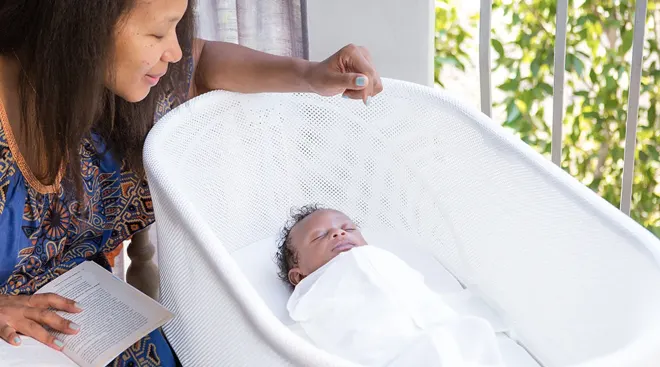How to Recognize the Signs of an Overtired Baby
As any parent knows all too well, getting baby to sleep can be tricky—and figuring out how to get an overtired baby to sleep, well, that’s even trickier. An overtired baby will likely have trouble sleeping and staying asleep, which, in turn, may make them even more overtired and more unlikely to get good sleep. It’s a vicious cycle. But many parents may not recognize that baby is overtired in the first place. Ready to learn how to identify your little one’s cues? Here are signs that you’ve got an overtired baby on your hands, plus some expert tips for getting them back on track—because a well-rested baby is a happier baby (and family).
Different babies may have slightly different sleep needs, says Jennifer Waldburger, MSW, co-founder of Los Angeles-based Sleepy Planet Parenting and co-author of The Sleepeasy Solution. “Generally, these are guidelines that work well for most babies, but there are always outliers—some who need a little more sleep or a little less.” she adds. That said, she suggests using this framework as a starting point and adjusting if baby genuinely thrives on more sleep or less.
0 to 4 months
Total sleep needed: 12 to 18 hours
In this newborn age range, there’s no division between day and night sleep—baby is on a round-the-clock sleep schedule. Enjoy the looseness while you can. “Babies have a giant cognitive growth spurt at around 3 to 4 months where they ‘wake up to the world’ in a major way and become much more alert and distractible,” says Waldburger. This growth spurt can disrupt their mood, behavior, feeding and—you guessed it—sleep. Babies who’ve slept relatively well up to this point may suddenly start waking at night or taking short naps.
Luckily, it should take just a few days to a couple weeks or so for the wow factor of this cognitive milestone to calm down. In the meantime, do whatever is necessary to help guide baby to sleep or back to sleep, Waldburger says. “Many babies will return to whatever their sleep patterns were prior to the milestone all on their own. If they don’t, at that point you can begin a sleep-learning process.”
4 to 6 months
Total sleep needed: 12 to 16 hours total (11 to 12 hours at night, and at least two daytime naps totaling three to four hours)
Being awake too long in between naps activates baby’s stress response, so pay attention to their wake windows, the length of time in between them waking from one nap and starting the next one.
Waldburger suggests aiming for two hours of awake time between when they wake up for the day and their first nap; two-and-a-half hours between the end of their first nap and the start of their second nap; two-and-a-half hours between the end of their second nap and the start of their third nap and about two hours between the end of their third nap and bedtime
6 to 9 months
Total sleep needed: 13 to 15 hours total (11 to 12 hours at night, and two to three daytime naps totaling three to four hours)
If baby is still taking three naps, Waldburger advises shooting to have two hours between the time baby wakes up for the day and baby’s first nap; two-and-a-half hours between the end of baby’s first nap and the start of their second nap and two-and-a-half hours between the end of their second and the start of their third. Finally, strive for about two hours between the end of their third nap and bedtime.
If baby is taking two naps, aim for two-and-a-half hours between waking for the day and their first nap (ideally, no earlier than 9 a.m.); three hours between their first nap and second and about two-and-a-half hours minimum between their second nap and bedtime, which will temporarily shift earlier when baby drops that third nap to compensate for the loss of daytime sleep.
A little heads up: New motor skills like crawling and standing can affect sleep. “To baby it feels like ‘Yippee, I can do this amazing new thing!’” Waldburger says. “Unfortunately, though, that can also mean some early morning wakings or short naps. Who wants to take a nap when you just won the lottery?” Waldburger suggests giving baby lots of floor time during the day to practice those new skills to tire them out, so they won’t save it up for the crib.
9 to 12 months
Total sleep needed: 13 to 15 hours total (11 to 12 hours at night, and one or two daytime naps totaling two to three hours)
If baby is still taking two naps, Waldburger says to try for two-and-a-half hours between the time baby wakes for the day and their first nap (again, ideally, no earlier than 9 a.m.); three hours between their first and second naps and about two-and-a-half hours minimum between the end of their last nap and bedtime.
If baby is taking one nap, aim for five or five-and-a-half hours between them waking for the day and napping, and five or five-and-a-half hours between the end of their nap and bedtime. “You’re shooting for roughly equal amounts of time between wakeup for the day and the start of the nap, and end of the nap and bedtime,” Waldburger adds. In terms of timing, 11:30 a.m. is usually a good nap time goal. Baby will generally sleep about the same amount in one nap that they used to do in two naps combined.
Once you know the signs of an overtired baby, you can be on the lookout for their cues. The key is anticipating and acting earlier than you think necessary, says Elizabeth King, founder of Sleep Baby Consulting, a pediatric sleep coaching firm based in Charlotte, North Carolina. “Don’t wait for your little one to start fussing before you decide they’re ready to sleep—it’s often too late! Instead, look for sleepy signals earlier in their wake time,” she says.
It helps to learn the difference between tired baby signs and overtired baby signs, Waldburger says. A tired baby might zone out a little and be less vocal and socially engaged, perhaps reducing eye contact and being in a state of quiet alertness. They may also be clingier than usual. On the other hand, Waldburger and King say that overtired baby signs include:
- Red eyelids or eyebrows
- Yawning
- Touching the face, (i.e rubbing eyes or tugging ears)
- Fussing that turns to crying (some babies have a higher pitched cry or whimper when they’re overtired)
- Being difficult to soothe
- Having short, fitful catnaps insead of long, nourishing sleeps
- Falling asleep at the “wrong” time, like while you’re feeding them or changing a diaper
- Overactivity or “wired” behavior
Many parents wait too long to put baby down, Waldburger says. “For babies under 3 to 4 months, you generally want to notice how much time elapses between sleep periods before you start seeing those signs of tiredness, and try to get them down 10 to 15 mins prior to that,” she advises. “For babies 3 to 4 months and up, you can follow more of a schedule where baby is awake for a certain amount of time appropriate for their age.”
“We’ve all had the feeling of being so tired that you aren’t tired, and babies are exactly the same,” says King. When babies are overtired, their brains release cortisol, a stress hormone that helps to regulate the body’s sleep-wake cycle, and adrenaline, the fight-or-flight agent.
Waldburger adds that cortisol’s purpose is to keep us awake when we need to be alert: “So basically when we’re overtired, our brains think we must have a good reason to be awake, and it floods our systems with increased energy. Having elevated levels of cortisol in your system creates a feeling similar to caffeine; even if you’re tired, you feel amped up.” Babies with elevated cortisol have trouble falling asleep, experience more fitful sleep and wake too early from sleep periods.
“The best way to deal with overtiredness is to avoid it in the first place,” advises King. Of course, life being life, that isn’t always possible. Sometimes baby stays up later than expected or you miss a nap. When that happens, you’ll want to make their environment extra calming and soothing, and you can try things like swaddling, using white noise or providing a pacifier to signal sleep.
To help an overtired baby get back on track, be prepared to spend a little extra time being present and hands-on. “You may have to help soothe baby back to sleep during the night, even if you don’t usually need to do that,” Waldburger says.
King often encourages her clients to take a “reset day” to help an overtired baby recover from sleep debt. The goal is to help baby get the best naps possible. “Then finish the day with an early bedtime… This gives their body a chance to recover some of that sleep debt and be able to better fall into a routine that’s going to be restful for them,” she says.
It can feel limiting to stick close to home just to adhere to baby’s sleep schedule. But it’s not forever (we promise!), and the upside is that by prioritizing a regular, consistent daily sleep schedule, baby will be well-rested and, ultimately, sleep better. Sleep begets sleep—and by maintaining some basic sleep hygiene habits, you can proactively keep baby’s sleep on track. Here are some steps you can take to avoid having an overtired baby:
- Learn baby’s signs. Watch for baby’s cues that they’re slowing down and ready for sleep.
- Watch the clock. Keep baby’s wake windows on track. “As a parent myself, I know the desire to keep them awake longer or give yourself more freedom during the day, but it’s much more fun to have a shorter outing with a happy baby than be stuck at a restaurant with a miserable baby who needs to go to bed,” King says.
- Put them down sleepy but still awake. Waldburger calls this “sleep shaping.” With babies 4 months and older, you want to help them learn to become more independent sleepers. “Instead of holding, bouncing, rocking or feeding baby all the way to sleep, you put baby down while still a little more wakeful, then stay nearby to pat, shush or reinsert the paci a few times, as they (hopefully!) learn how to do that last bit of falling asleep more independently,” she says. This self-soothing skill will enable baby to connect their sleep cycles so they can successfully sleep through the night.
- Aim for at-home sleeping. Whenever possible, try to crib-sleep at home. “On-the-go naps are often not as restorative or as long as naps in baby’s crib, and it’s important that we teach them to take long, beautiful naps rather than settling for 30- to 45-minute catnaps all day,“ King says.
- Use a consistent bedtime routine. Maybe it’s a bath, a book and a song. Whatever your nighttime routine, do it consistently, and use an abridged version before naps.
Waldburger offers this hot tip for breastfeeding moms: When labeling stored milk, indicate at what time of day the milk was produced. Why? Research shows that the composition of breast milk changes throughout the day, helping to program babies’ circadian rhythms. Breast milk produced at night has more prolactin and melatonin, both of which support sleep, whereas milk produced during the day has higher levels of cortisol and certain amino acids, supporting activity. Labeling stored milk accordingly can help parents avoid giving milk that may promote activity when it’s time for baby to sleep.
Overtired parents of overtired babies, hang in there. With these tips, you should hopefully be well on your way to more healthful and restful sleep—for both of you.
Please note: The Bump and the materials and information it contains are not intended to, and do not constitute, medical or other health advice or diagnosis and should not be used as such. You should always consult with a qualified physician or health professional about your specific circumstances.
Plus, more from The Bump:
Elizabeth King is a certified baby sleep consultant and founder of Sleep Baby Consulting, a pediatric sleep coaching firm in Charlotte, North Carolina.
Jennifer Waldburger, MSW, is a sleep consultant, parenting educator and the co-founder of Sleepy Planet Parenting, and the co-author of The Sleepeasy Solution: The Exhausted Parent's Guide to Getting Your Child to Sleep from Birth to Age 5.
Stanford Medicine Children’s Health, Newborn Sleep Patterns
Nemours KidsHealth, Sleep and Your 4- to 7-Month-Old, July 2022
Stanford Medicine Children’s Health, Infant Sleep
Healthy Children (American Academy of Pediatrics), Movement: Babies 8 to 12 Months, April 2021
Healthy Children (American Academy of Pediatrics), Swaddling: Is it Safe for Your Baby?, July 2022
University of Pittsburgh Medical Center, Benefits of White Noise for Babies, October 2022
Sleep Foundation, Can a Newborn Baby Sleep With a Pacifier?, March 2022
Cleveland Clinic, Should Your Baby Have a Bedtime Routine?, August 2022
Nutrients, Circadian Variation in Human Milk Composition, A Systematic Review, August 2020
Learn how we ensure the accuracy of our content through our editorial and medical review process.
Navigate forward to interact with the calendar and select a date. Press the question mark key to get the keyboard shortcuts for changing dates.








































![Tan France, celebrity personality from the popular TV shoe]w Queer Eye.](https://images.ctfassets.net/6m9bd13t776q/2uqRZn7bkb4nWv28drOW16/98b7493289f8f84d699ffa7516be8f90/tan-france-baby-sleep-products-660x367.jpg?fm=webp&q=75&w=660)











